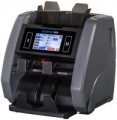Types of bills sorting provided in the device. Sorting itself is found both in specialized note and in coin counters (see "Product Type"). This paragraph is describing the criteria of sorting types which can be processed. However, in devices for coins, only one criterion is used —
by denomination ; so basically this list is relevant for paper money sorters. In such models, in addition, sorting
by face,
by orientation,
by dilapidation and
by date of issue can also occur. Here are the features of each of these options:
— By face. Sorting type that allows you to lay out all the bills face up. With this procedure, bills are divided into two trays, depending on which side they are up; after that, it is enough to take one of the stacks and turn it over as necessary. It should be noted that this function is most often combined with sorting by orientation (see below) — these types of sorting allow you to bring all bills exactly in one position, which is important, for example, before loading into an ATM.
— By orientation. Sorting that allows you to separate bills lying "upside down". Such bills are sent to a separate pocket, after the end of the procedure, it is enough to remove there the entire pack and turn it to the desired orientation. This feature is often combined with the sort by face d
...escribed above, but can be used separately and is generally much more common. This is due to the fact that ordering both by orientation and by face is required relatively rarely — mainly when loading into an ATM and in other similar types of machine money processing; and for convenience, when counting by a person, it is not necessary to place all the bills in exactly the same way — it is enough to deploy them in one orientation.
— By denomination. Sorting of recounted money by denomination. It should be reminded that this is the only type of sorting used not only for bills, but also for coins; specific capabilities of devices with this function may be different. So, the simplest option is to separate bills that do not correspond to some denomination, or that have a denomination more or less a certain value. This operating mode is found only in models for paper money. A more advanced way is sorting by several denominations at once — for example, 1, 5 and 10, or 5, 10 and “greater than 10”. The specific number of simultaneously available denomination options may be different, it can be determined by the number of receiving pockets (see above for more details, but here we recall that in general there are more such pockets in coin devices than in bills sorters).
— Fitness sorting. A feature that allows you to identify bills with obvious signs of dilapidation: old, worn, etc. One of the most popular ways to use this feature is to select money to fill ATMs: such bills should be as new as possible. In addition, sorting by dilapidation can be useful for general purposes — to detect bills of unsatisfactory quality and exchange them for new ones at an authorized banking institution.
— By date of issue. A rather specific feature that is rarely found — mainly in professional-level devices. This is due to the fact that sorting by year of issue is usually not needed in daily work with the cash register, it is used in some special tasks — for example, identifying old (or obsolete) bills for subsequent exchange for new ones.
